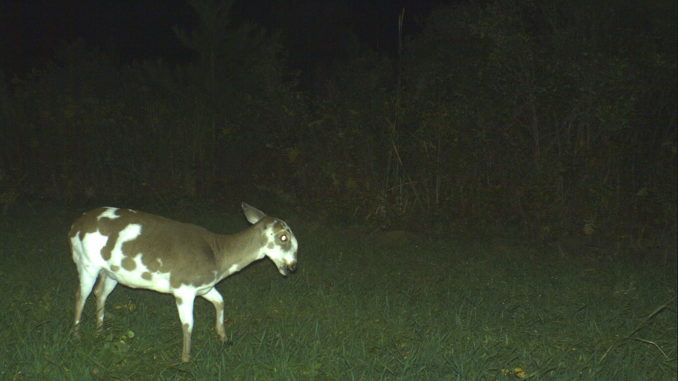
Unique coloration of albino, piebald deer offer hunters in the Carolinas a unique trophy opportunity.
At the beginning of each deer season, hunters thumb through thousands of trail-camera photos, glass peanut or soybean fields, and think about ways to get a wall-hanger into range.
For most hunters, a heavy 10-pointer with a 20-inch spread will make a season one to remember. But some hunters get a chance to take a deer that looks entirely different, covered either in patches or with a completely white coat. And for many, it’s just as satisfying as taking that 10-point buck.
What transforms a normal whitetail deer into a piebald, aka calico, or the most-extreme, an albino with pink eyes? Are they mutants? Are they poisoning or jeopardizing the health of the herd? Should they be protected or targeted for immediate removal?
According to Dr. Jonathan C. Shaw, the N.C. Wildlife Resources Commission’s deer biologist, deer with abnormal white patches and albinos are a result of genetic anomalies.
“When you get right combination of alleles in the genetic code, the white traits show up,” he said. “They are rare animals, with fewer than one percent expressing piebald characteristics and much less for albinos.”
While piebald and albino deer both express white characteristics, they are genetically different. Albinos are completely white, with have pink eyes and hooves. Piebald deer have random white splotches on their bodies, without any pattern whatsoever, but they have other physical struggles to overcome that will often affect survival rates.
Charles Ruth, deer and wild turkey program coordinator for the S.C. Department of Natural Resources, explains that piebald deer have issues beyond just coloration that can affect their survival.
“Piebald deer have other congenital issues that predispose the animal for poor survival as fawns. Many have severe overbite, malformed legs and feet, scoliosis of the spine and organ issues,” he said. “The color issues in albino deer are related only to the absence of hair and skin pigments. There are no other issues other than the color.”
These genetic anomalies are hereditary and are carried by animals that express the white traits — and by normal deer that don’t express any white characteristics at all. These white colorations are recessive traits in the genome.
“Females and males each contribute 50 percent of the genetics to their offspring,” Ruth said. “Since these traits are normally recessive genes, their parents are normal. It is coincidental that two individuals with the recessive traits happen to get together to produce an offspring that expresses the characteristic.”
These individual deer don’t have a dramatic effect on the population, with one exception: they are more susceptible to predation. Hunters and predators can pick out a white animal better than a deer with a normal coat.
“It is more of a novelty and related to an individual animal or a very small number of related animals at the local level that have resulted from the coincidental mating of parents that have the genetics to produce the traits. They are mostly a dead end,” Ruth said.
Shaw did much of his research at N.C. State University on deer dispersal. His research indicates the dispersal rate alone makes it very difficult to manage to retain or eliminate deer with white traits. Deer are constantly moving, and both bucks and does disperse great distances each year, at all ages, but the greatest permanent migrations are as fawns.
“Seventy-five percent of buck fawn crop and 20 percent of the doe fawn crop will take off and disperse when they are one year of age. In addition, several times a year, all of them go on an excursion of several miles, and many of these excursions are during the breeding season; that can spread the genes across the landscape,” he said.
Bottom line, it is nearly impossible to influence the genetic makeup of a population of deer that includes piebald and albinos.
“A normal-looking deer can carry the genes,” Shaw said.
So should hunters shoot or protect piebald and albino deer? It is up to the person behind the trigger or the four-bladed broadhead. There are no herd-health benefits from shooting or passing up a deer with white characteristics.
Shaw’s philosophy is to treat them just as other deer; shooting or passing one up will not have any dramatic effect either way. When they show up on trail-camera footage, in food plots or in shooting lanes, they can be easy targets to pick out, and they can take up a nice spot on the grill.




Be the first to comment